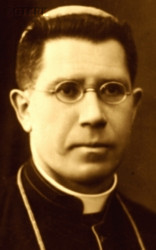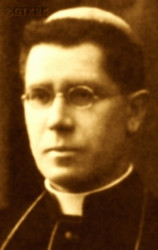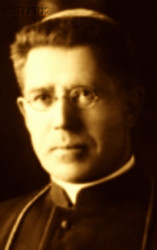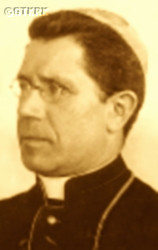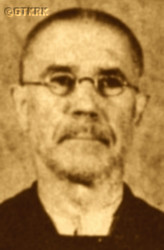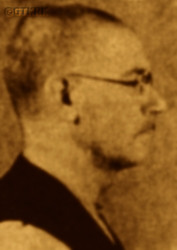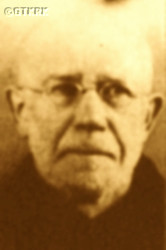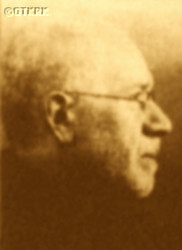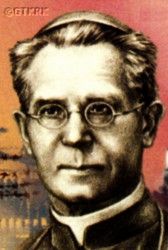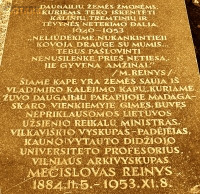Roman Catholic
St Sigismund parish
05-507 Słomczyn
85 Wiślana Str.
Konstancin deanery
Warsaw archdiocese, Poland
full list:
displayClick to display full list

searchClick to search full list by categories
wyświetlKliknij by wyświetlić pełną listę po polsku

szukajKliknij by przeszukać listę wg kategorii po polsku

Martyrology of the clergy — Poland
XX century (1914 – 1989)
personal data
surname
REINYS
forename(s)
Mieczyslav (pl. Mieczysław)
forename(s)
versions/aliases
Mečislovas
function
archbishop
creed
Latin (Roman Catholic) Church RCmore on
en.wikipedia.org
[access: 2014.09.21]
diocese / province
Vilnius archdiocesemore on
en.wikipedia.org
[access: 2013.05.19]
Samogitia diocesemore on
www.catholic-hierarchy.org
[access: 2021.12.19]
Vilnius diocesemore on
en.wikipedia.org
[access: 2013.05.19]
academic distinctions
Doctor of Philosophy
Theology MA
honorary titles
Cross of Vytis (Lithuania) — Commander's Grand 2nd Classmore on
en.wikipedia.org
[access: 2025.02.11]
(08.01.2003)
nationality
Lithuanian
date and place
of death
08.11.1953

VladimirVladimir on the Klyazma River
today: Vladimir city reg., Vladimir oblast, Russia
more on
en.wikipedia.org
[access: 2022.01.06]
details of death
After the end of World War I, during Polish–Russian war of 1919‐1920, arrested by the Russians in 1919 in Vilnius.
Held in Dyneburg and Smolensk prisons.
From 1922 — after incorporation of Vilnius into Poland — moved to Lithuania.
During World War II, which began with the German and Russian invasion of Poland in 09.1939, after the commencement in 06.1941 — as a result of the German attack on the former ally and occupant of Vilnius, the Russians — the German occupation and the arrest of Abp Jałbrzykowski by the Germans in 1942, took over the duties of the ordinary of the Archdiocese of Vilnius.
Engaged in elimination of Polish priests persecuted by the Germans and signs of Polishness from the diocese entrusted to him — e.g. removed from the Litany to the Mother of God the calling to the „Queen of the Polish Crown”.
After the end of the World War II and start of another Russian occupation in 1944, arrested on 12.06.1947 by the Russians.
Accused of „collaboration with anti–Russian nationalist clandestine underground and irreconcilable hostility to the Russian Soviet system”.
Held in Vilnius prison.
On 15.11.1947 sentenced by the Russians to 8 years in prison.
Held in Vladimir on the Klyazma River prison where perished.
cause of death
extermination
perpetrators
Russians
sites and events
Vladimir (on Klaźma river)Click to display the description, Vilnius (Łuskis Square)Click to display the description, Ribbentrop‐MolotovClick to display the description, Pius XI's encyclicalsClick to display the description, Polish‐Russian war of 1919‐1921Click to display the description
date and place
of birth
05.02.1884

Madagaskarastoday: Antalieptė eld., Zarasai dist., Utena Cou., Lithuania
more on
lt.wikipedia.org
[access: 2020.07.31]
parents
REINYS Jerome
🞲 ?, ? — 🕆 ?, ?

MALIŠAUSKAITĖ Julianna
🞲 ?, ? — 🕆 ?, ?
presbyter (holy orders)
ordination
10.06.1907

Sankt Petersburgtoday: Saint Petersburg city, Russia
more on
en.wikipedia.org
[access: 2020.07.31]
positions held
1940 – 1953
titular archbishop ad–personam — Cypsela RC archdiocese — appointment: on 18.07.1940
1940 – 1953
auxiliary bishop (Lat. episcopus auxiliaris) — Vilnius RC archdiocese — appointment: on 18.07.1940
c. 1942 – c. 1947
apostolic administrator — Vilnius RC archdiocese — during the imprisonment of Abp Romuald Jałbrzykowski by the Germans (1942‐1944) and after the arrest of Abp Romuald Jałbrzykowski by the Russians (1945) and his deportation by the Russians to the Russian–occupied Poland (1945‐1947)
1926 – 1940
titular bishop — Tiddi RC diocese — appointment: on 05.04.1926; ordination: on 16.05.1926, St Peter and St Paul the Apostles cathedral in Kaunas
1926 – 1940
bishop – coadiutor — Vilnius RC archdiocese — appointment: on 05.04.1926; with responsibility for part of Archdiocese in Republic of Lithuania (Vilkaviškis region)
1925 – 1926
Foreign Minister — (Republic of Lithuania territory)today: Lithuania
more on
en.wikipedia.org
[access: 2022.01.06]
from 1922
director — Kaunastoday: Kaunas city dist., Kaunas Cou., Lithuania
more on
en.wikipedia.org
[access: 2022.06.29] ⋄ Department of Psychology, Universitas Vytauti Magni [i.e. Vytautas Magnus University (from 1930) / University of Lithuania (1922‐1930)] — also: professor of theology and philosophy
1922 – 1924
professor — Kaunastoday: Kaunas city dist., Kaunas Cou., Lithuania
more on
en.wikipedia.org
[access: 2022.06.29] ⋄ Theological Seminary
1916 – 1922
professor — Vilniustoday: Vilnius city dist., Vilnius Cou., Lithuania
more on
en.wikipedia.org
[access: 2022.01.06] ⋄ Theological Seminary — lecturer in philosophy, sociology and social sciences
1914 – 1916
vicar — Vilniustoday: Vilnius city dist., Vilnius Cou., Lithuania
more on
en.wikipedia.org
[access: 2022.01.06] ⋄ RC parish ⋄ Vilniustoday: Vilnius city dist., Vilnius Cou., Lithuania
more on
en.wikipedia.org
[access: 2022.01.06] RC deanery
1913 – 1914
student — Strasbourgtoday: Bas‐Rhin dep., Grand Est reg., France
more on
en.wikipedia.org
[access: 2022.01.06] ⋄ philosophy of religion, University of Strasbourg [i.e. Fr. Université de Strasbourg (Eng. University of Strasbourg) / Kaiser Wilhelm University (1872‐1918)] — postdoctoral studies in apologetics
1912 – 1913
student — Louvaintoday: Flemish Brabant prov., Flemish reg., Belgium
more on
en.wikipedia.org
[access: 2020.11.07] ⋄ Faculty of Natural Sciences, Université Catholique de Louvain (pl. Catholic University of Leuven) — postdoctoral studies in natural sciences (e.g. biology) and psychology
1909 – 1912
PhD student — Louvaintoday: Flemish Brabant prov., Flemish reg., Belgium
more on
en.wikipedia.org
[access: 2020.11.07] ⋄ philosophy and theology, Université Catholique de Louvain (pl. Catholic University of Leuven) — PhD thesis „Foundations of morality according to Vladimi Soloviev”, public defense in 1912
1905 – 1909
student — Sankt Petersburgtoday: Saint Petersburg city, Russia
more on
en.wikipedia.org
[access: 2020.07.31] ⋄ philosophy and theology, Imperial Roman Catholic Spiritual Academy (1842‐1918)
1901 – 1905
student — Vilniustoday: Vilnius city dist., Vilnius Cou., Lithuania
more on
en.wikipedia.org
[access: 2022.01.06] ⋄ philosophy and theology, Theological Seminary
others related
in death
SZEPTYCKIClick to display biography Casimir Mary (Fr Clement), JANULAITISClick to display biography Francis, LAUKAITISClick to display biography Joseph, MATULIONISClick to display biography Theophilus, MIRONASClick to display biography Vladislav
sites and events
descriptions
Vladimir (on Klaźma river): On of the harshest Russian prisons for political prisoners where dozens of catholic priest were held.
Vilnius (Łuskis Square): In the former Tsarist prison and 1918‐1939 Polish Republic voivodeship buildings at Łukiski Square (Ofiarna Str.) Germans in 1941 set up the Gestapo HQ and jail and Russians in 1944 the Vilnius HQ of the genocidal NKVD/MGB organisation. Thousands of Polish soldiers of resistance Home Army AK (part of Polish Clandestine State), Lithuanian partisans and during Russian occupation after 1944 — German collaborators were interrogated and tortured there. In the basements death sentences were carried out. In 1944‐1960 alone Russians carried out more then 1,000 death sentences there — some of the bodies were secretely buried in a nearby Tuskulanum palace in Vilnius. (more on: en.wikipedia.orgClick to attempt to display webpage
[access: 2017.06.16])
Ribbentrop‐Molotov: Genocidal Russian‐German alliance pact between Russian leader Joseph Stalin and German leader Adolf Hitler signed on 23.08.1939 in Moscow by respective foreign ministers, Mr. Vyacheslav Molotov for Russia and Joachim von Ribbentrop for Germany. The pact sanctioned and was the direct cause of joint Russian and German invasion of Poland and the outbreak of the World War II in 09.1939. In a political sense, the pact was an attempt to restore the status quo ante before 1914, with one exception, namely the „commercial” exchange of the so‐called „Kingdom of Poland”, which in 1914 was part of the Russian Empire, fore Eastern Galicia (today's western Ukraine), in 1914 belonging to the Austro‐Hungarian Empire. Galicia, including Lviv, was to be taken over by the Russians, the „Kingdom of Poland” — under the name of the General Governorate — Germany. The resultant „war was one of the greatest calamities and dramas of humanity in history, for two atheistic and anti‐Christian ideologies — national and international socialism — rejected God and His fifth Decalogue commandment: Thou shall not kill!” (Abp Stanislav Gądecki, 01.09.2019). The decisions taken — backed up by the betrayal of the formal allies of Poland, France and Germany, which on 12.09.1939, at a joint conference in Abbeville, decided not to provide aid to attacked Poland and not to take military action against Germany (a clear breach of treaty obligations with Poland) — were on 28.09.1939 slightly altered and made more precise when a treaty on „German‐Russian boundaries and friendship” was agreed by the same murderous signatories. One of its findings was establishment of spheres of influence in Central and Eastern Europe and in consequence IV partition of Poland. In one of its secret annexes agreed, that: „the Signatories will not tolerate on its respective territories any Polish propaganda that affects the territory of the other Side. On their respective territories they will suppress all such propaganda and inform each other of the measures taken to accomplish it”. The agreements resulted in a series of meeting between two genocidal organization representing both sides — German Gestapo and Russian NKVD when coordination of efforts to exterminate Polish intelligentsia and Polish leading classes (in Germany called «Intelligenzaktion», in Russia took the form of Katyń massacres) where discussed. Resulted in deaths of hundreds of thousands of Polish intelligentsia, including thousands of priests presented here, and tens of millions of ordinary people,. The results of this Russian‐German pact lasted till 1989 and are still in evidence even today. (more on: en.wikipedia.orgClick to attempt to display webpage
[access: 2015.09.30])
Pius XI's encyclicals: Facing the creation of two totalitarian systems in Europe, which seemed to compete with each other, though there were more similarities than contradictions between them, Pope Pius XI issued in 03.1937 (within 5 days) two encyclicals. In the „Mit brennender Sorge” (Eng. „With Burning Concern”) published on 14.03.1938, condemned the national socialism prevailing in Germany. The Pope wrote: „Whoever, following the old Germanic‐pre‐Christian beliefs, puts various impersonal fate in the place of a personal God, denies the wisdom of God and Providence […], whoever exalts earthly values: race or nation, or state, or state system, representatives of state power or other fundamental values of human society, […] and makes them the highest standard of all values, including religious ones, and idolizes them, this one […] is far from true faith in God and from a worldview corresponding to such faith”. On 19.03.1937, published „Divini Redemptoris” (Eng. „Divine Redeemer”), in which criticized Russian communism, dialectical materialism and the class struggle theory. The Pope wrote: „Communism deprives man of freedom, and therefore the spiritual basis of all life norms. It deprives the human person of all his dignity and any moral support with which he could resist the onslaught of blind passions […] This is the new gospel that Bolshevik and godless communism preaches as a message of salvation and redemption of humanity”… Pius XI demanded that the established human law be subjected to the natural law of God , recommended the implementation of the ideal of a Christian state and society, and called on Catholics to resist. Two years later, National Socialist Germany and Communist Russia came together and started World War II. (more on: www.vatican.vaClick to attempt to display webpage
[access: 2023.05.28], www.vatican.vaClick to attempt to display webpage
[access: 2023.05.28])
Polish‐Russian war of 1919‐1921: War for independence of Poland and its borders. Poland regained independence in 1918 but had to fight for its borders with former imperial powers, in particular Russia. Russia planned to incite Bolshevik‐like revolutions in the Western Europe and thus invaded Poland. Russian invaders were defeated in 08.1920 in a battle called Warsaw battle („Vistula river miracle”, one of the 10 most important battles in history, according to some historians). Thanks to this victory Poland recaptured part of the lands lost during partitions of Poland in XVIII century, and Europe was saved from the genocidal Communism. (more on: en.wikipedia.orgClick to attempt to display webpage
[access: 2014.12.20])
sources
personal:
pl.wikipedia.orgClick to attempt to display webpage
[access: 2018.09.02], www.catholic-hierarchy.orgClick to attempt to display webpage
[access: 2021.12.19]
bibliographical:
„Lexicon of Polish clergy repressed in USSR in 1939‐1988”, Roman Dzwonkowski, SAC, ed. Science Society KUL, 2003, Lublin
original images:
mikalojus.ltClick to attempt to display webpage
[access: 2018.09.02], www.vilnensis.ltClick to attempt to display webpage
[access: 2018.09.02], lk.katalikai.ltClick to attempt to display webpage
[access: 2018.09.02], genocid.ltClick to attempt to display webpage
[access: 2018.09.02], www.vilnensis.ltClick to attempt to display webpage
[access: 2018.09.02], www.vilnensis.ltClick to attempt to display webpage
[access: 2018.09.02], www.propatria.ltClick to attempt to display webpage
[access: 2018.09.02], www.propatria.ltClick to attempt to display webpage
[access: 2018.09.02], commons.wikimedia.orgClick to attempt to display webpage
[access: 2018.09.02], vanderkrogt.netClick to attempt to display webpage
[access: 2018.09.02], commons.wikimedia.orgClick to attempt to display webpage
[access: 2018.09.02], ipn.gov.plClick to attempt to display webpage
[access: 2019.02.02], cmentarznarossie.uksw.edu.plClick to attempt to display webpage
[access: 2025.03.20]
LETTER to CUSTODIAN/ADMINISTRATOR
If you have an Email client on your communicator/computer — such as Mozilla Thunderbird, Windows Mail or Microsoft Outlook, described at WikipediaPatrz:
en.wikipedia.org, among others — try the link below, please:
LETTER to CUSTODIAN/ADMINISTRATORClick and try to call your own Email client
If however you do not run such a client or the above link is not active please send an email to the Custodian/Administrator using your account — in your customary email/correspondence engine — at the following address:

giving the following as the subject:
MARTYROLOGY: REINYS Mieczyslav
To return to the biography press below:
 Click to return to biography
Click to return to biography








